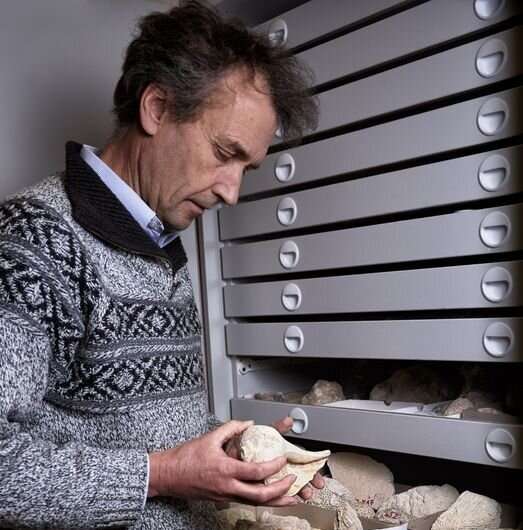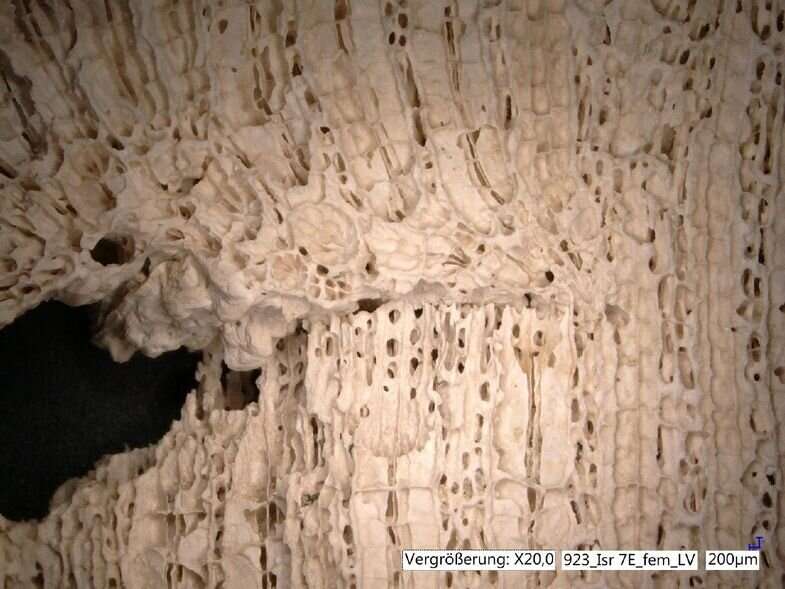What 40-million-year-old tropical reef corals tell us about climate change

Unusually well-preserved reef corals from the Geological and Paleontological Collection at Leipzig University hold a great secret: They allow us to travel far into the past and reconstruct climatic conditions in our latitudes. Researchers from Leipzig University, the Universities of Bremen and Greifswald, and UniLaSalle in Beauvais have now succeeded in doing just this. Using chemical analyses, they were able to model seasonal temperature fluctuations of this period and show for the first time that corals already lived in symbiosis with algae 40 million years ago. Their results, which may also serve to improve current climate forecasts, have been published in the journal Science Advances.
In the Middle Eocene, some 40 million years ago, a tropical climate prevailed in our latitudes: It was warm and humid, as evidenced by fossils from Lake Geiseltal near Halle, for example. It was so warm, in fact, that coral reefs extended far to the north—to about the 45th degree of latitude, roughly the level of present-day southern France. Some of these tropical reef corals are now fossils in Leipzig University’s Geological and Paleontological Collection. They come from the Paris Basin, a large marine bay that extended into what is now France.
Among these fossils, Professor Thomas Brachert and his team found some very special corals: They were not fossilized like many others, but escaped this process. “This makes them a wonderful environmental archive. A coral skeleton grows every year much like a tree. But what is special about it is that the skeleton is something of an archive of several hundreds to a thousand years of climate history,” said Professor Thomas Brachert from the Institute of Geophysics and Geology at Leipzig University.

Skeleton reveals small seasonal temperature fluctuations
The geologist and his team took samples from the coral’s calcareous skeleton and analyzed the material using geochemical methods. Based on the chemical properties, the scientists were able to deduce the temperature of the water in which the corals lived. The ratio of oxygen isotopes in the samples showed that the seasonal temperature differences were very small for this latitude. They correspond to about half of the current value of 15 degrees Celsius difference between seasons. “This means that our study confirms what had been expected but could never be measured so well: the fact that there were very small seasonal differences in the planet’s warm periods,” says Brachert.
New discovery: Corals already lived in symbiosis back then
The researchers also investigated the feeding habits of corals 40 million years ago. By analyzing the carbon isotopes, they were able to show for the first time that even back then corals lived in a symbiosis with unicellular “algae,” so-called zooxanthellae. These perform photosynthesis, giving the sugar they produce to the coral. The coral in turn digests the sugar and returns important nutrients to the algae for photosynthesis. But if the seawater gets too hot, the corals expel the algae and starve to death. So they were already susceptible to coral bleaching back then and probably affected by it repeatedly.

Study data to improve current climate calculations
The research team’s data not only allows conclusions to be drawn about the climate in the Middle Eocene, it can also be used to improve current climate models. “We can use our new findings about extreme warm periods as a comparison for the future. Our current computer models are based on assumptions that are not necessarily all correct. On the basis of our data, we can make assessments of the extent to which these models provide useful results,” summarized Professor Thomas Brachert.
Climate resilient microalgae could help restore coral reefs
Thomas C. Brachert et al, Slow-growing reef corals as climate archives: A case study of the Middle Eocene Climatic Optimum 40 Ma ago, Science Advances (2022). DOI: 10.1126/sciadv.abm3875
Citation:
What 40-million-year-old tropical reef corals tell us about climate change (2022, May 23)
retrieved 23 May 2022
from https://phys.org/news/2022-05-million-year-old-tropical-reef-corals-climate.html
This document is subject to copyright. Apart from any fair dealing for the purpose of private study or research, no
part may be reproduced without the written permission. The content is provided for information purposes only.
For all the latest Science News Click Here
For the latest news and updates, follow us on Google News.

